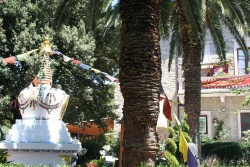Istituto Lama Tzong Khapa
The Istituto Lama Tzong Khapa (ILTK) in Pomaia, a village in Tuscany, in Italy (40 km south of Pisa) is a branch of the Foundation for the Preservation of the Mahayana Tradition (FPMT), an international network of Gelugpa dharma centers.
It is named for Tsongkhapa, founder of the Gelugpa monastic order of Tibetan Buddhism.
The Dalai Lama has taught there on several occasions.
Established in 1977 by the FPMT founders, Lamas Thubten Yeshe and Thubten Zopa Rinpoche, the ILTK offers various courses on Tibetan Buddhism in Italian, English, and (to a lesser extent) several other European languages.
Of these, the most noteworthy is a six-year (formerly seven) "Masters Program" designed for the training of FPMT teachers.
The Masters Program
The ILTK Masters Program is based on several previous (and abortive) attempts to abbreviate and adapt the course of studies traditional among Gelugpa monks, to an audience whose members did not come from this background (i.e., the Western dharma students who formed the bulk of the FPMT's members).
The first was a 12-year program designed by Lama Yeshe for the Manjushri Institute in Ulverston (Cumbria, England).
Begun in 1978, it was taught by Geshe Jampa Tegchok, with assistance from Western monk Thubten Pende.
It fell victim to factional struggle between followers of Lama Yeshe and Geshe Kelsang Gyatso.
In 1982 a similar program was begun at Nalanda Monastery (France) with the same teachers, but failed to attract sufficient interest.
In 1980, Lama Yeshe asked his old friend and colleague from Sera Monastery, Geshe Jampa Gyatso, to become resident teacher in Pomaia.
Geshe Jampa began teaching elements of Lama Yeshe's curriculum in 1983, though unsystematically.
With the help of several FPMT educators (Thubden Pende and Joan Nicell), plans for the formal course were created.
The first "Masters Program" was held between 1998 and 2004.
About thirty students finished the course, with others participating in portions of it.
A second course began in 2008, with some modifications, and is scheduled to continue until 2013.
Geshe Jampa Gyatso died before it commenced, resulting in the appointment of his junior colleague, Geshe Tenzin Tenphel, as course teacher.
In 2009 Geshe Tenphel resigned from this role, to be succeeded by Khensur Rinpoche Jampa Tegchok.
Five major texts are studied:
- 1. The Abhisamayalamkara (Ornament of Clear Realization), a commentary on the Prajnaparamitasutras, revealed by Maitreya to ::Asanga;
- 2. The Madhyamakavatara of Chandrakirti;
- 3. The Abhidharmakosa of Vasubandhu;
- 4. Kirti Losang Trinle's exposition on the Grounds and Paths of Secret Mantra (commenting on Tsongkhapa's Great Exposition ::of the Stages of the Path of Tantra); and
- 5. Aku Sherab Gyatso's commentary on the Guhyasamaja Tantra.
Of these, the first three (along with works by Dharmakirti and Gunaprabha) constitute the major texts of the Gelugpa Geshe curriculum (cf.
Tibetan Buddhist canon)
The last two are associated with Gelugpa tantric colleges, Gyuto and Gyume, whose students traditionally entered after earning a Geshe degree.
Guhyasamaja is a major tantric practice emphasized by Gelugpa lineages, owing perhaps to its prominence in the writings of Tsongkhapa (emphasized in the original, expanded curriculum as designed by Lama Yeshe).
In addition to the formal studies described above, participants engage in several meditation retreats, mostly focused on lamrim topics.
Students are not expected to observe the five precepts, but are asked to aim at conduct according with them.
The Masters Program course includes both resident (in Pomaia) and on-line participants.
Both groups receive a certificate upon completion, with the residential students additionally qualifying as FPMT teachers.
Despite the name, the ILTK does not actually award a masters degree.
Other Courses
Similar to other FPMT centers, the ILTK also offers short-duration courses such as lamrim.
Some of these are modules in sequences such as "Discovering Buddhism" (two years of weekend study) or the FPMT's "Basic Program" (a standardized sequence of seven courses which requires several years to complete).
In addition to Tibetan Buddhist subjects, ILTK also offers "alternative" courses on such subjects as hatha yoga, qigong, Sufism, astrology, aromatherapy, and massage. Psychological counseling services are also available.
Other activities
ILTK has been a member of the Unione Buddhista Italiana (Italian Buddhist Union) since that organization's founding in 1984, and served as its headquarters until 1992 (when the UBI opened offices in Rome).
UBI is a lobby group seeking various forms of government recognition for Italian Buddhist institutions.
ILTK hosts regular conferences of the "Mindfulness Project," which is devoted to dialogue between Buddhism and counseling psychology.
Since 1983 ILTK has published an Italian-language newsletter—now a thrice-yearly magazine—entitled Siddhi.
It also manages a press, JTK Publications (JTK for "Je Tsong Khapa"), devoted to Italian-language Buddhist books and other material.
Affiliated Sangha
In 1978, Khyabje Song Rinpoche ordained five monks in Pomaia.
Their monastery,Tagden Shedrub Dhargye Ling ("Place Where Study and Practice Proliferate Uninterruptedly"), was built during the 1980s under the patronage of Lama Zopa.
It was the first Gelugpa monastery in Italy.
Two of its monks, Pierro Cerri and Claudio Cipullo, were also among the founders of ILTK.
In 1984, six monks and one nun formed the Italian International Mahayana Institute, a cultural organization.
The group (possibly defunct?) had two categories of membership: monastic and lay.
A nunnery, Shenpen Samten Ling ("[Place of Concentration Benefiting Others)]"), opened in 1989 under the patronage of Lama Zopa. Books
In Buddhism in the Modern World (Steven Heine & Charles S. Prebish, eds), Oxford UP: 2003, ch. 9. Cozort discusses the ILTK's Masters Program in the context of the overall educational curricula of the FPMT, which he compares with the traditional system of Sera Je Monastery as well as that another Western organisation, the New Kadampa Tradition.
